The Complete Guide for Camel-Riding
Camel rides are a kind of activity everybody does when they visit the Middle East, especially if they take Israel and Jordan tours. The ride is a great way to experience the traditional, easy way to explore desert landscapes and feel a bit like Lawrence of Arabia. But camels are not horses, and a tourist who doesn't know how to approach them is in for a nasty surprise.
This professional guide, written with help from our field experts in Jordan and Israel, will make sure you'll have a great time on your camel ride. let’s take a look at the history of this splendid beast, what it’s like to ride one, and how to prepare yourself before you hop between its hump.
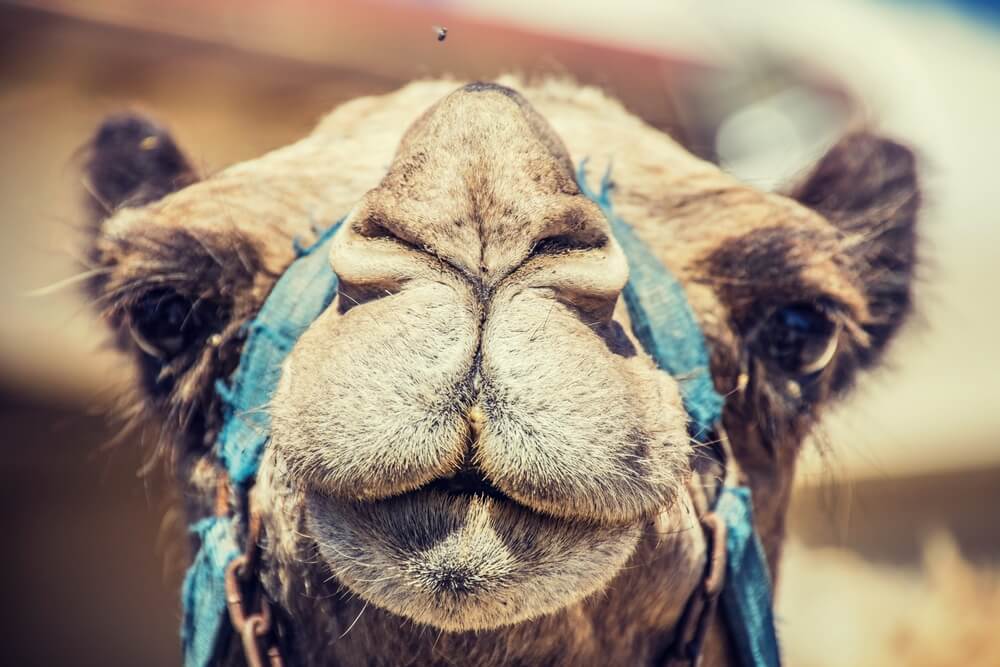 Oh, hi there! are we going for a ride?
Oh, hi there! are we going for a ride?
Camels in Arabic Culture
The word ‘camel’ in Arabic actually means ‘beautiful’ and whilst this is not perhaps the first word that comes to mind when describing these animals, it’s true to say they do have a certain charm.
Native to the Middle East (and also North Africa/Asia) in Arabic culture, camels are a symbol of strength and hardship. After all, for thousands of years they were the primary means of moving across desolate and inhospitable terrain. They were (and still are) prized as resilient beasts of burden who provide tasty meat (the hump being the most prized part).
As for their distinctive features, the Dromedary has one hump and the Bactrian two. Dromedaries make up 90% of the world’s population and they are the ones you’ll see if you‘re traveling in the Middle East.
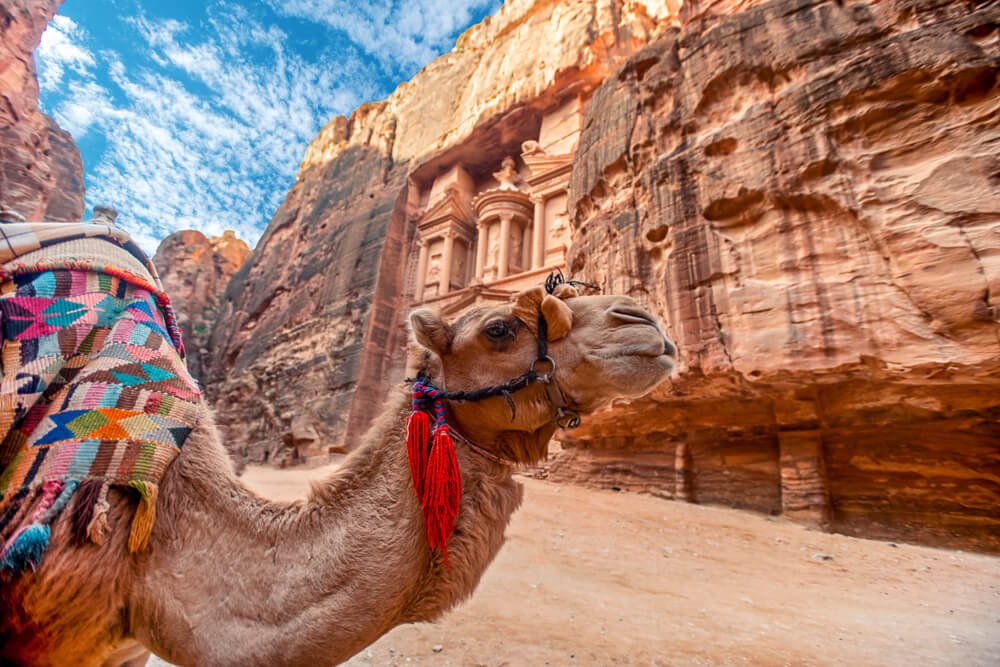 A Camel next to the Petra Treasury, Jordan
A Camel next to the Petra Treasury, Jordan
Hardy Beasts of Burden
A common myth is that their humps are filled with water but that’s not true! In actual fact, the hump is a place to store fat, which can be transformed at short notice into an instant energy source - this means camels can actually go up to six months without food!
Other features that make camels hardy for desert life include double rows of long eyelashes and nostrils that can shut easily - this helps them when sandstorms hit. They can also survive on seeds, dried leaves, and thorny plants when food cannot be found in the desert - and because they have thick lips and a large number of teeth (34), the thorns won’t even injure them!
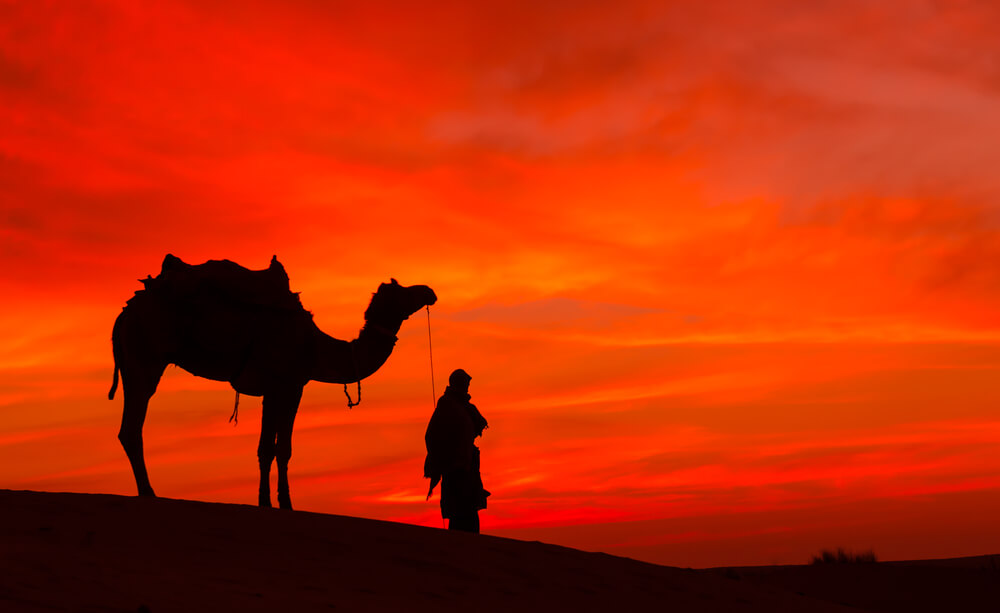 King of the Desert. A Camel and its driver
King of the Desert. A Camel and its driver
Is it fun to ride a Camel?
Yes, it really can be. After all, what better way to see the hot, shimmering desert than from high up, trekking silently in formation across sand dunes, leaving nothing in your wake but footprints?
Many adults, and almost all kids, love the experience. Sure, you’ll be bobbing up and down a bit, and you might disembark with sore legs, but as long as you have a positive approach, chances are you’re going to have fun.
The other thing to remember is you won’t be alone - you’ll be in a group, led by experienced Bedouins, who have an intimate relationship with the animals and know exactly how they need to be treated. And because they were born and raised in the desert, they know the terrain incredibly well, which means you’re in safe hands.
 Sit back and enjoy the ride!
Sit back and enjoy the ride!
What to wear when riding a Camel?
When riding a camel, it is important to wear clothing that is comfortable, loose-fitting and provides protection from the sun and the elements. Here are some things to keep in mind:
Clothing: Prefer lightweight, breathable clothing that covers your arms and legs to protect you from the sun and from any brush or thorns that you may encounter. Loose-fitting clothing is ideal as it allows for ease of movement. Cotton or other natural fibers are good choices. Oh, and don't forget to wear a hat!
Footwear: Closed-toe shoes or boots with a sturdy soles are recommended. This will protect your feet from the stirrups.
Layering: If you are riding in the early morning or evening when temperatures can be cooler, consider wearing layers that can be removed as the day warms up.
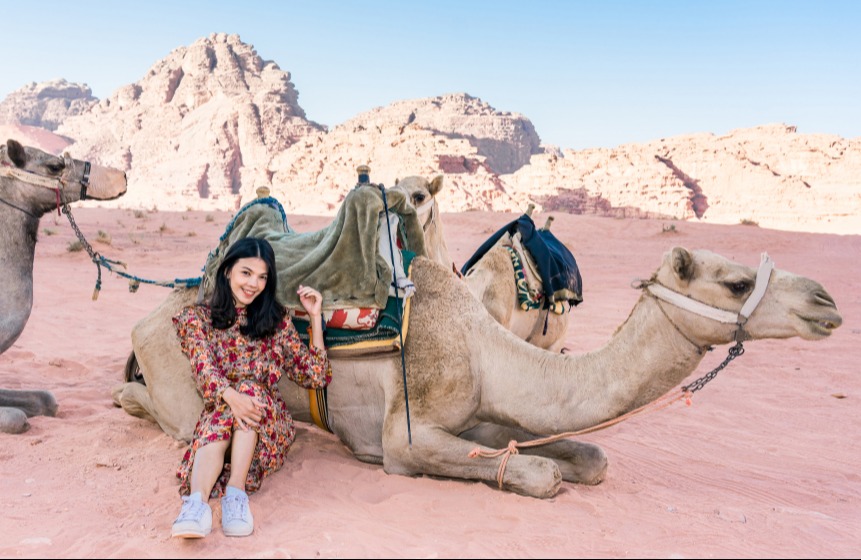 Camels resting in Wadi Rum, Jordan
Camels resting in Wadi Rum, Jordan
What to expect when Camel Riding
So what does it actually feel like to go camel riding? Well, whilst it’s certainly fun, as we’ve said above, the truth is that it’s not always entirely comfortable or easy! Here are a few things to expect before you get going:
Camels grunt, gurgle, and huff; they also moan and bellow loudly. This is their way of communicating with each other. Occasionally, they may even grind their teeth! Don’t be scared - it’s all part of the experience!
Camels move slowly - be aware that you won’t be racing across the desert, rather plodding along at a slow and steady pace.
Camels are stubborn - if they don’t want to do something, you’ll have a fight on your hands. If things get tricky, however, the Bedouin guides will step in to help you.
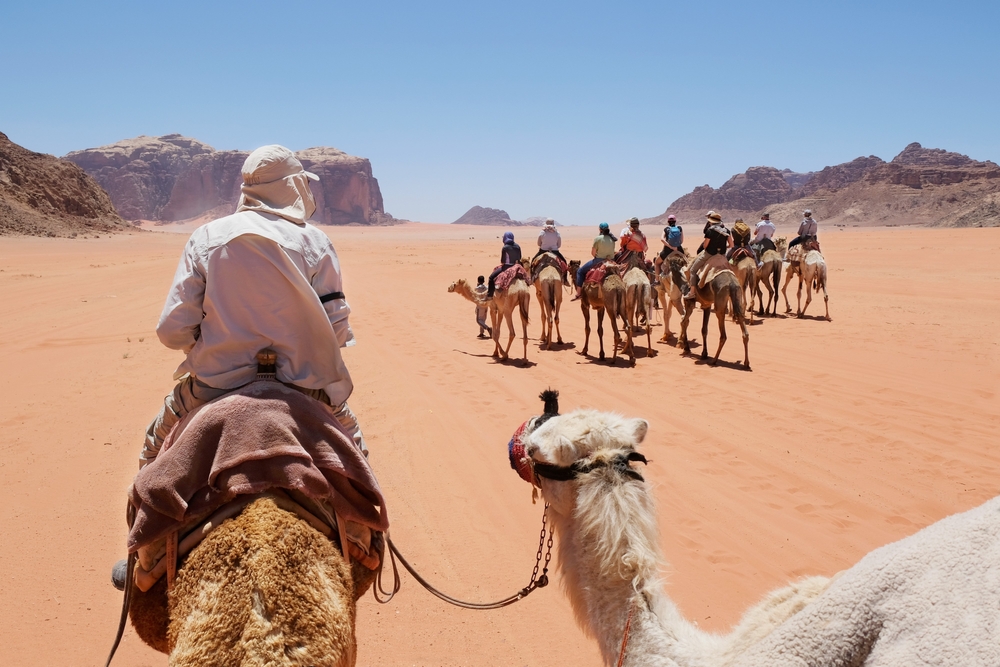 Camel Riding in Wadi Rum, Jordan
Camel Riding in Wadi Rum, Jordan
Tips for Riding a Camel
Avoid being bitten or kicked: if you’re going horse riding, it’s likely that if you pet your horse, or give them some straw beforehand, they will reach out and smell your hand. Unfortunately, this is not the case for camels - in fact, if you reach out to stroke one, you might end up bitten or kicked.
Fun fact: whilst horses only kick forward and backward, camels can kick in all four directions. Having said this, camels can also be very friendly and gentle, so please don’t worry too much - just go with your instincts.
Mounting and dismounting your camel: First of all, make sure the camel is kneeling down (ask a Bedouin guide for help, to hold the animal still, if necessary). Then put your left foot in the stirrup and swing your right leg over. Once you’re on, grab onto your saddle firmly with both hands. Lean back as your camel stands up - you’re then good to go.
Controlling your camel: This is where your reins come in. On the right side of the camel’s head, the rein will control its direction. On the left side is the rein you’ll use to deal with speed. When you want your camel to move forward, pull on both reins together - but to make it stop, give just the left rein a tug. Oh - and if you want your camel to turn around, loosen one rein and pull the other tight!
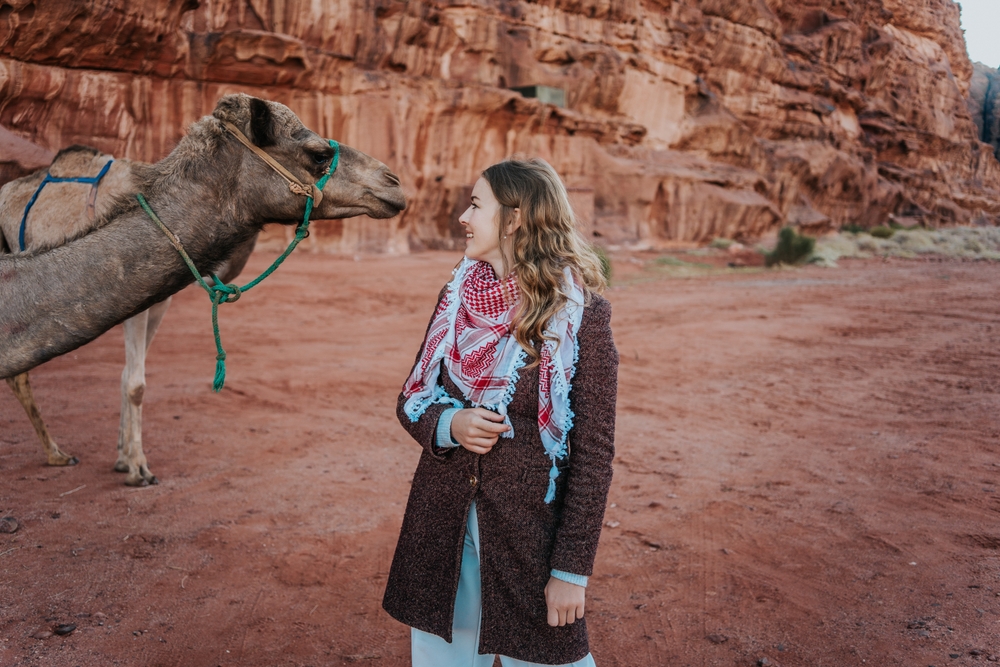 Camels could be super-nice!
Camels could be super-nice!
Do Camels Spit?
Camels spit a lot although, technically, it’s not spitting - they’re actually bringing up the contents of their stomach, and mixing them with saliva. This ‘regurgitation’ can seem alarming but it only really happens when they feel threatened.
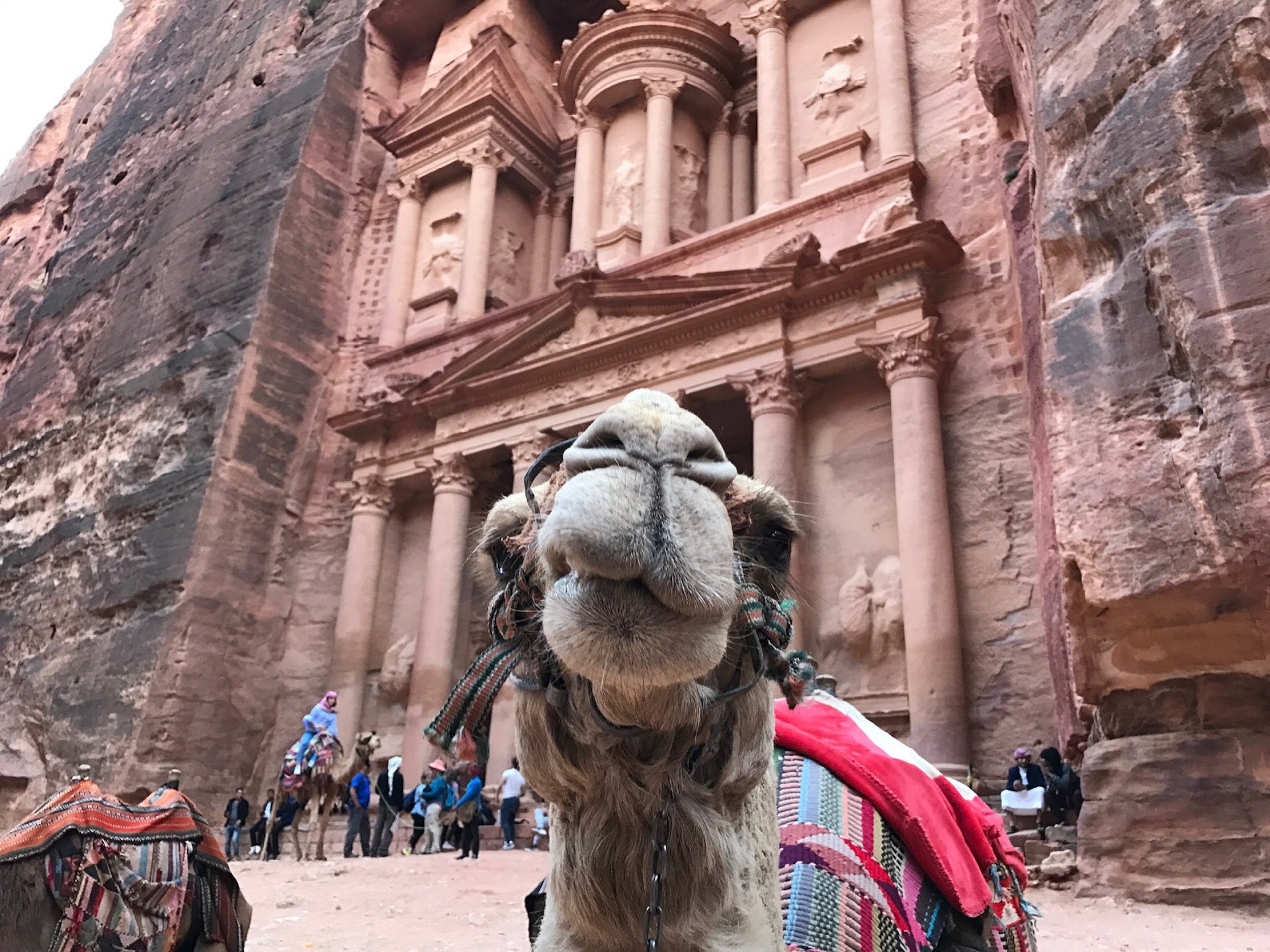 A Jordanian Camel in front of the famous Petra Treasury
A Jordanian Camel in front of the famous Petra Treasury
Are Camels faster than Horses?
No, horses are generally faster. Camels are known for their ability to travel long distances in hot and dry environments, but they are not typically used for speed. The average speed of a camel is around 20-25 miles per hour (32-40 km/h), whereas horses can reach speeds of up to 40-45 miles per hour (64-72 km/h).
Having said that, Camels are better adapted to travel over sand and rough terrain than horses, which can make them faster in certain situations. Camels have large, padded feet that are well-suited for walking on sand and their wide-spaced legs provide stability in uneven terrain. In addition, camels have a unique gait that minimizes the amount of energy they use and reduces the impact on their joints, which can help them move more efficiently over rough ground.
Horses can still be faster than camels over short distances because they are able to reach higher speeds. Overall, the relative speed of camels and horses will depend on the specific conditions of the terrain and the distance being covered.
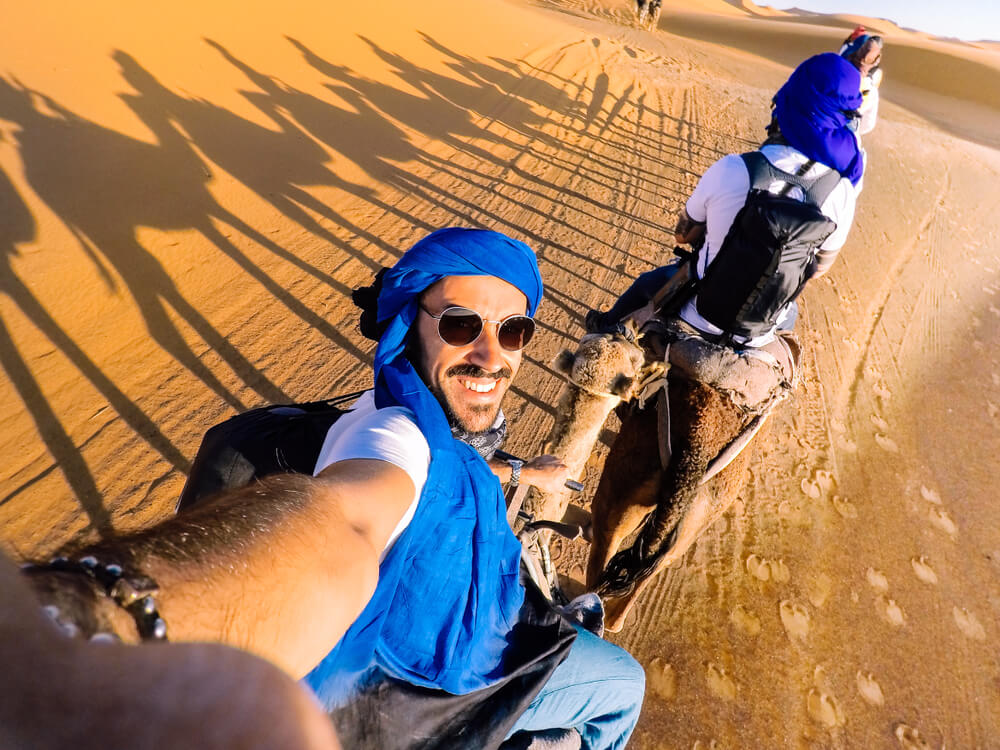 You won't go fast, but you'll have a great time!
You won't go fast, but you'll have a great time!
What do you call a Camel with three Humps?
"Pregnant"; there are no camels with three humps on their backs. The single-humped camels are known as Dromedary Camels, the double-humped are called Bactrian Camels, and the three-hump thing is just an old joke.
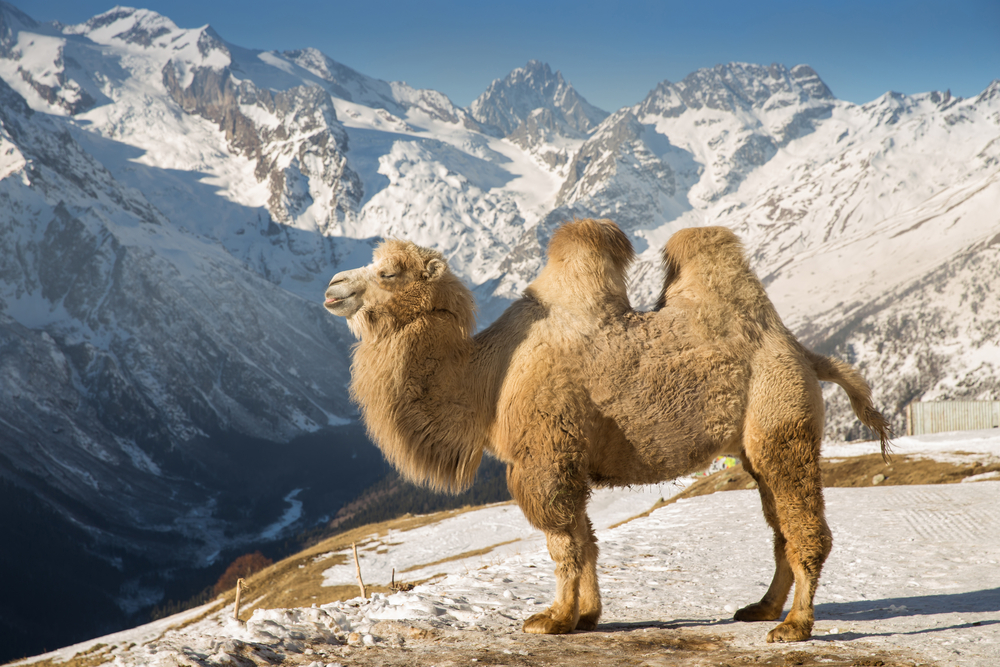 The Bactrian Camel is not amused
The Bactrian Camel is not amused
Camel Riding in Jordan
Jordan is the perfect place for camel rides; the combination of ancient cities carved into red cliffs in Petra, otherworldly sceneries in Wadi Rum, and a mystic atmosphere just loops in every adventurous soul - and well, the scene won't be complete without a traditional camel ride.
You can get a camel ride at every glamping site in Wadi Rum, and all around Petra. Camel rides can be booked also from the Visitor’s Centre in Wadi Musa, the city right outside the Petra Archeological Park.
Finally, if you’re interested in taking Petra and Wadi Rum tours, feel free to click or just contact us; our field experts in Jordan are the best and will make sure you'll have a great vacation.
 Login / Register
Login / Register
 Contact Us
Contact Us
 Certificate of Excellence
Certificate of Excellence Guaranteed Departure
Guaranteed Departure Low Prices Guaranteed
Low Prices Guaranteed 24/7 Support
24/7 Support




